RBA interest rates: AMP reckons slowing wages suggest jobs market may have cooled

Aussie wage growth slowed to 3.2 per cent in the year to December as economists battle over the chances of another interest rate cut by the Reserve Bank.
The pace was down from 3.6 per cent growth for September, and below economist expectations.
It came as Judo Bank chief economist Warren Hogan tipped the Reserve Bank will cut interest rates again in April.
Sign up to The Nightly's newsletters.
Get the first look at the digital newspaper, curated daily stories and breaking headlines delivered to your inbox.
By continuing you agree to our Terms and Privacy Policy.Mr Hogan had been among the strongest advocates to keep the cash rate elevated to fight inflation but warned the RBA was responding to widespread pressure.
“We expect to see a possible follow-up and final rate cut at the next board meeting on April Fool’s Day,” he said.
“The RBA cannot simply cut rates once prior to an election as this will look politically motivated.
“Another rate cut will make this change to interest rates look more like a traditional policy adjustment reflecting economic conditions.”
Mr Hogan said a campaign by unions, some academics and financial markets had pressed the central bank to act.
“The RBA board was clearly concerned that to hold rates steady yesterday would risk widespread criticism that it is ‘smashing the economy’,” he said.
Governor Michele Bullock’s board lowered the benchmark interest rate by 0.25 percentage points to 4.1 per cent on Tuesday but she warned “we cannot declare victory just yet”. Markets were too optimistic about the pathway for future cuts, she said.
Yet investors overnight priced in a 79 per cent chance of an April relief, despite the tough talking from Ms Bullock.
UBS and Bank of America on Wednesday picked May for the next cut.
Slowing wages add to the case that price pressure has been squeezed from the economy — despite low unemployment suggesting the jobs market is still hot.
The pace of wage growth was below expectations and the lowest since mid-2022.
The RBA had on Tuesday projected 3.2 per cent wage growth in 2024 but expected that would accelerate to 3.4 per cent by June.
“Wages growth has declined quickly from its peak, driven by slowing employment markets’ conditions throughout 2023-24 and is clear evidence of the labour market not as red hot as previously feared, despite a low unemployment rate,” AMP’s My Bui said.
“Slowing wages growth does not mean doom and gloom for wage earners though, because inflation has continued to tick down, and real wages growth continues to be positive.”
Positive real wage growth means worker pay is rising faster than inflation.
Ms Bui said wages would still have a long way to go to catch up to the overall surge in cost of living since 2020.
EY senior economist Paula Gadsby said the numbers would give the RBA comfort that wages were not stoking inflation. It was an indicator inflation was moving sustainably back into the 2 to 3 per cent target band, Ms Gadsby said.
“But productivity growth has not picked up and will need to improve to ensure this level of wage increases does not renew inflationary pressures.“
